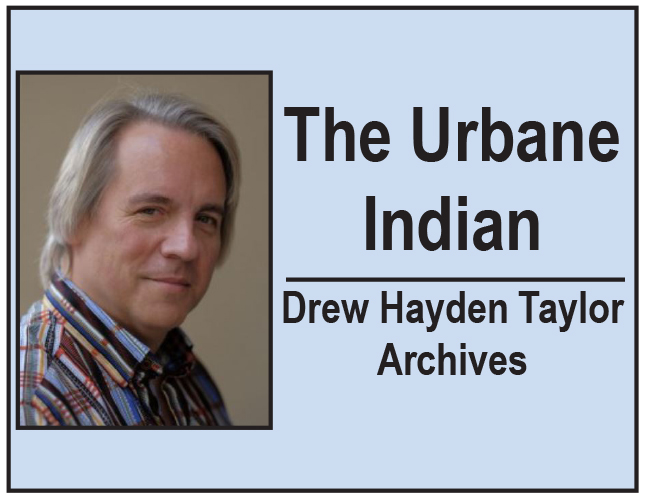
By Drew Hayden Taylor
Originally published in November 2016
Indigenous activist and world-renowned architect Douglas Cardinal lost his bid in Ontario Superior Court to stop the Cleveland Indians baseball team from using its “racist name” and Chief Wahoo mascot logo during the American League Championship Series games played in Toronto against the Blue Jays.
The application also named Rogers Communications Inc., which broadcast the games.
Cardinal’s lawyer, Michael Swinwood, said the Cleveland Indians’ team name and mascot Chief Wahoo, the cartoonish image of a man with red skin, a toothy imbecilic grin, and a feather in his headband are offensive and discriminatory to Native people.
This was just the latest salvo in an ongoing battle against what many consider to be the politically incorrect names of numerous professional sports teams. But in this age of equity, diversity and inclusion, it’s becoming more and more difficult to understand what is socially acceptable when referring to Aboriginal people, sports and other complex issues.
The standard argument is that these team names renders an entire race of people and their culture to that of inanimate objects, a maple leaf or a sabre, an animal, manta ray or penguins, or ruthless and desperate people, buccaneers or pirates.
It is also pointed out that you don’t see other ethnically offensive names peppering the sports page like the New York Jews or the Detroit Blacks or the Phoenix Latinos. Just Native people.
The counter perspective says instead the monikers honour Native people. However, a good chunk of those people being honoured might disagree. And if those being honoured disagree about being honoured, does that indeed honour them?
I heard one person arguing that people of Nordic heritage aren’t voicing any discontent about the Minnesota Vikings football team.
Vikings, to the best of my knowledge, are no longer pillaging and raping their way along the coastline of Europe, while Native people are still a vibrant and participating North American presence, small but distinct difference.
I would like to point out though, that some of my best friends are Vikings.
Canada’s First Nation population are not afraid to address this controversial topic. You might even say…. the Natives are restless.
So in the interest of good community relations and keeping the lines of communication open, I would like to offer a humble glossary of familiar terms no longer acceptable to the average Indigenous person you might casually pass walking down the street.
Let’s start with the obvious: Sports teams.
Cleveland Indians—I don’t think so. To most Native people, the logo is generally considered offensive. Add to that, I doubt very much there are many Indians (North American or South Asians) on the actual team, much like actual Canadiens playing for the Montreal Canadiens. It’s a symbol of a bygone era, and should be relegated to such.
Washington Redskins—Just a general misnomer. Native people don’t actually have red skins. Some say that belief dates back to the Beothuk who used to coat their body with red ochre. Today, generally, Native people’s skin colour runs the gamut from snow to eggshell to cream all the way through to nut brown, wheat, and shades of dusty copper. The only redskin seen in our communities are those that come back from Mexico in February.
Atlanta Braves—two words—tomahawk chop. You don’t see Blue Jays fans pretending to eat worms. This is also the state that, as part of a land grab, sent most of its Indigenous population on what was called the Trail of Tears.
Thousands died on a long forced march in the 1830s to what was referred to as the Indian territories, today called Oklahoma. Nothing particularly brave about that.
Edmonton Eskimos—If I remember correctly, a survey/poll was done a year or so ago asking local residents if they thought the team should consider changing the contentious name of the Canadian football team. The answer was a resounding no. So the team will continue to acknowledge the fact they come from Edmonton.
Common phrases that litter contemporary language use:
Having a powwow: Frequently used to describe a gathering or meeting of some general sort. Commonly heard when a coach, catcher and pitcher are in conference on the mound.
This is not a powwow. There are no dancers, no drummers, no Indian tacos. Native people do not, on average, meet on large mounds of dirt. This is a gathering of highly paid non-Native professionals. This is a board meeting.
Off the reservation: A phrase usually used to describe someone’s actions that are not socially, or ethically, acceptable. In the Canadian Native community, when we say ‘off the reservation’ (or more accurately off-reserve), we mean going to a place with adequate housing, drinkable water, decent education and medical care.
The beat of a different drum: This is not as controversial as other sayings due to the fact that many cultures around the world use drums in their social and spiritual activities. Generally speaking, First Nations are very pro-beating different drums. Think of how boring the world would be if there was only one drum to beat. And crowded.
The cavalry coming to the rescue: That one should be fairly easy. From the Aboriginal perspective, our position should be quite self-evident.
Native or First Nation: This is the number one question the Aboriginal people of this land get asked. “What the hell should we call you guys now?” Complex question because it varies, depending if you are on the reserve, in the city, at a university, working in government, getting a pedicure, etc. In order to cover all the bases (sports metaphor), I recommend the term NAFNIP: Native Aboriginal First Nations Indigenous Person/People.
